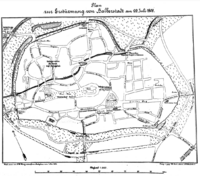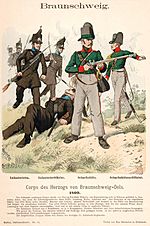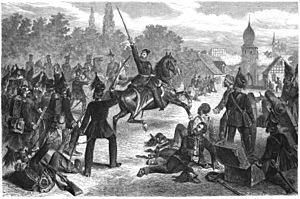Battle of Halberstadt facts for kids
Quick facts for kids Battle of Halberstadt |
|||||||
|---|---|---|---|---|---|---|---|
| Part of the War of the Fifth Coalition | |||||||
 Plan of the storming of Halberstadt |
|||||||
|
|||||||
| Belligerents | |||||||
| Commanders and leaders | |||||||
| Frederick William, Duke of Brunswick-Wolfenbüttel | P-S Mayronnet | ||||||
| Strength | |||||||
| 2,110 | 1,980 plus local troops | ||||||
| Casualties and losses | |||||||
| c. 400 | c. 600 and 2,080 captured | ||||||
The Battle of Halberstadt was a fight that happened on July 29 and 30, 1809, in a town called Halberstadt. This town was then part of the Kingdom of Westphalia. The battle was part of a bigger conflict known as the War of the Fifth Coalition. In this battle, a group of soldiers called the Black Brunswickers, led by Frederick William, Duke of Brunswick-Wolfenbüttel, surprised and defeated Westphalian troops. The Brunswickers were trying to reach the North Sea coast.
Why the Battle Happened
Frederick William, Duke of Brunswick-Wolfenbüttel had a tough time. His father died in battle, and his home, the Duchy of Brunswick, was taken over by Napoleon Bonaparte in 1807. Napoleon made it part of his new Kingdom of Westphalia, which was ruled by his brother, Jérôme Bonaparte.
While in exile, Duke Frederick decided to fight back. He gathered a group of volunteers, known as a freikorps, to fight against the French and their German allies. The Austrian Empire helped equip these volunteers. Their uniforms were mostly black, which earned them the nickname Schwarze Schar ("Black Horde"). In English, they were known as the "Black Brunswickers."
The Black Brunswickers fought alongside the Austrian Army in the summer of 1809. However, the Austrians signed a peace agreement, the Armistice of Znaim, on July 12. Duke Frederick refused to stop fighting. He wanted to join forces with the United Kingdom, which was still fighting Napoleon.
The Duke and his Black Brunswickers began a long march towards the north German coast. They started from Zwickau on July 24. On July 26, they entered the town of Halle in Westphalia and took its money. This made Jérôme Bonaparte angry. He ordered three generals, Jean-Jacques Reubell, Pierre Guillaume Gratien, and Claude Ignace François Michaud, to gather their soldiers and stop the Brunswickers.
The Battle of Halberstadt
The closest Westphalian soldiers to the Duke's path were the 5th Westphalian Infantry Regiment. This group had 1,980 soldiers and was guarding Magdeburg. They were told to join General Reubell's division before fighting the Brunswickers.
The 5th Infantry, led by Colonel P-S Mayronnet, arrived in Halberstadt at 11 AM on July 29. They were still 150 kilometers away from Reubell's forces. At 1 PM, local police officers, called gendarmes, warned Mayronnet that the Brunswickers were in Quedlinburg, about 14 kilometers away.
Colonel Mayronnet didn't act quickly. He might have thought the Brunswickers would take a long time to reach Halberstadt. He was surprised when they approached the town at 5 PM. He sent out his light infantry, called voltigeurs, to form a skirmish line. The rest of his soldiers defended the gates of the old town walls, helped by the town's own guards.
At 7 PM, Duke Frederick led one group of his soldiers against the Harsleber Gate. A second group attacked the Kuhlinger Gate, and a third attacked the Johannis Gate. Even though the Westphalians fought bravely, all three gates were broken through. Obstacles, like carts full of manure, were cleared away.
The Brunswickers rushed into the town, shouting their battle cry of Seig oder todt! ("Victory or death!"). When their cavalry reached the main square, they found Mayronnet's strong group of reserve soldiers. But these Westphalian soldiers thought they were surrounded by more enemies, so they surrendered.
By midnight, most of the town was under Brunswick control. Only two companies of the 5th Infantry, called grenadier companies, held out. They had barricaded themselves inside some large houses. But they finally surrendered at 5 AM when the Duke brought his cannons into position outside.
The Westphalian forces lost about 600 soldiers killed or wounded. Another 2,080 were captured, and their regimental colours (flags) were taken. The Brunswick Corps lost about 400 soldiers killed or wounded.

What Happened Next
The Duke of Brunswick continued his march on the same day, July 30. He took 200 of his prisoners with him, as they decided to join his army. He first headed to his old capital, the city of Brunswick. He hoped to find more new soldiers there, but not many joined.
General Reubell tried to block his path outside Brunswick at the Battle of Ölper on August 1. However, the Westphalians made a mistake by leaving under the cover of darkness. This allowed the Black Brunswickers to continue their march north.
Their enemies chased them closely, but the Black Brunswickers finally reached the coast at Elsfleth on August 6. There, they got onto Royal Navy ships and sailed to England. The Brunswick Corps later fought with the British Army in the Peninsular War and the famous Waterloo Campaign.


